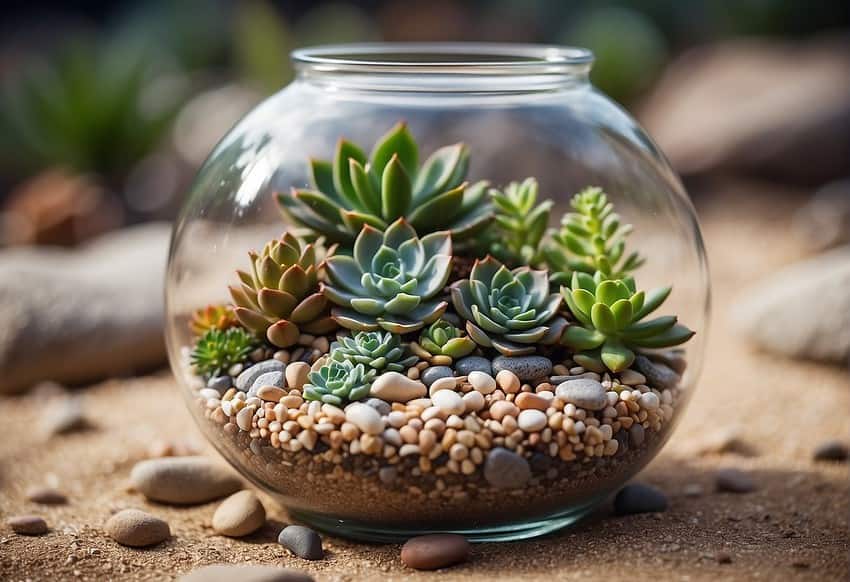Creating a desert terrarium brings a piece of the arid wilderness into the home. Suited for those with a love for minimalist landscapes and hardy plants, a desert terrarium is an enclosed environment that mimics the conditions of desert ecosystems, allowing for the cultivation and display of succulents and other desert-dwelling plants. This type of project appeals to both gardening enthusiasts and those looking to add a touch of nature’s resilience to their living spaces.
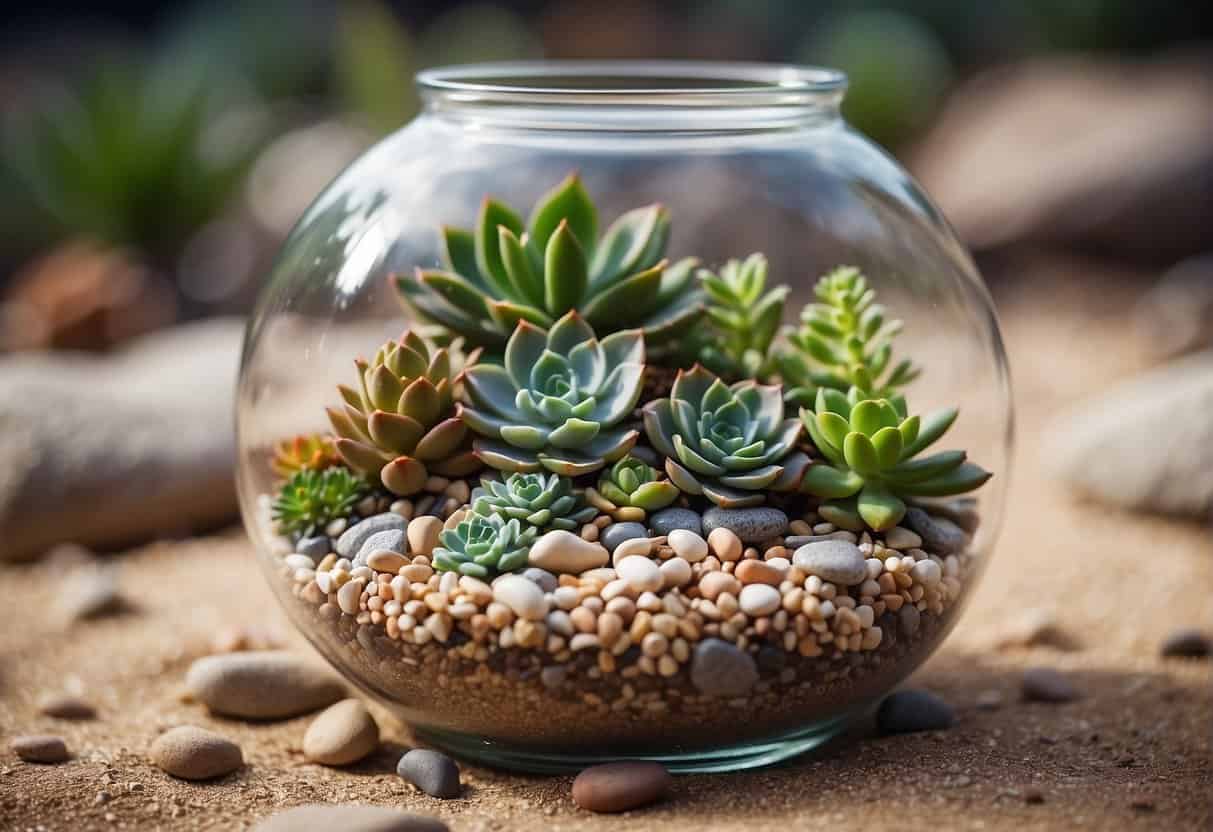
Succulents, the stars of these miniature sandscapes, are favored for their low maintenance and ability to thrive in dry conditions. They are well-suited to life inside a terrarium, where conditions can be controlled and tailored to replicate the desert environment. You can create a thriving and visually stunning display by selecting the right container, appropriate soil mix, and an array of desert plants.
The process of creating a desert terrarium involves careful planning and execution. Proper layering of materials ensures drainage and the health of the plants, while the aesthetic arrangement of sand, rocks, and plants can capture the stark beauty of the desert. This hands-on project is not only a creative exercise but also an opportunity to learn more about desert flora and the art of terrarium making.
Choosing the Right Container
When embarking on the creation of a desert terrarium, the selection of the appropriate container is pivotal. It sets the stage for your miniature arid landscape, influencing both the health of the succulents and the visual appeal of the arrangement.
Container Types and Materials
Glass containers are the quintessential choice for desert terrariums due to their clear and sturdy material, which provides excellent visibility and allows for ample light penetration. They often come in various shapes, from traditional bowls to modern geometric designs, offering a plethora of choices for aesthetics and functionality. Materials like plastic or acrylic may be more durable, but they lack the same clarity and may, over time, become cloudy, thereby diminishing the terrarium’s visual appeal.
Size and Shape Considerations
The size and shape of the container dictate the number and type of plants it can support. For a desert terrarium, where plants like cacti and succulents prefer a dry environment. A shallow and wide container is often adequate, ensuring proper air circulation and preventing moisture buildup. A standard terrarium should have a minimum size to maintain a healthy micro-environment, with the specifics depending on the number of plants and the desired design.
Visibility and Aesthetics
Visibility is a crucial aspect of a desert terrarium. A clear glass container with minimal embellishments offers an unobstructed view of the layered sand, stones, and plants, showcasing the terrarium’s intricate decor. The shape of the container should complement the design. For instance, a tall and narrow vessel may suit a single, striking succulent, while a broad, low bowl could display a crafted desert scene more effectively. The choice of container should always enhance, not detract from, the serene beauty of the miniature landscape within.
Essential Supplies for Your Terrarium
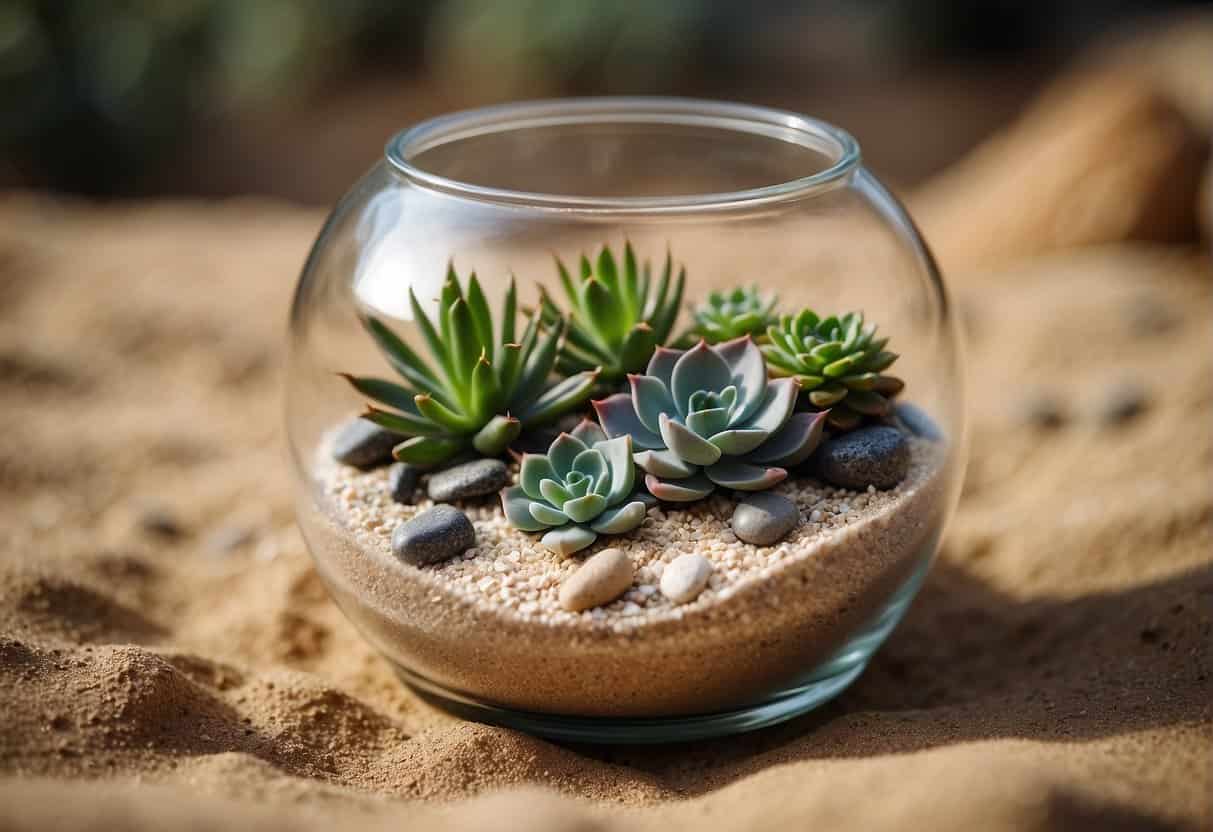
Before embarking on the creation of a desert terrarium, it is vital to gather specific supplies to ensure the environment thrives. Proper soil composition, substrate layers, and aesthetic elements come together to replicate a desert ecosystem.
Types of Soil and Substrate
In the realm of desert terrariums, achieving the right soil composition is paramount for the health and well-being of the enclosed plants. The emphasis here lies on creating a well-draining environment to mimic the arid conditions of natural desert landscapes. Sand, a fundamental component, is carefully blended with soil and peat to deter water retention, ensuring that the soil doesn’t become overly saturated. Incorporating loam into the soil mix is a strategic choice, serving a dual purpose. Not only does loam contribute to effective drainage, preventing soggy conditions, but it also replicates the texture of the native soil found in arid regions. This careful balance in soil composition caters to the specific needs of desert plants, fostering an environment that aligns with their natural habitat. The result is a desert terrarium that showcases the beauty of arid flora and provides an optimal substrate for their growth, striking a harmonious balance between the aesthetic and functional aspects of plant care.
Selecting Appropriate Sand and Gravel
In the intricate world of desert terrariums, sand emerges as a multifaceted ally, seamlessly blending practicality with aesthetics. Its first crucial role lies in its ability to facilitate drainage, preventing excess water from lingering around plant roots and creating a habitat reminiscent of arid landscapes. This functional aspect is paramount, mimicking the natural conditions where swift drainage is vital for the survival of desert plants. Simultaneously, the presence of sand contributes to the overall visual appeal of the terrarium, embodying the very essence of a desert environment.
Complementing the role of sand, gravel steps onto the stage as another indispensable player in the terrarium’s ecosystem. Strategically positioned at the container’s base, gravel enhances drainage capabilities, forming a reliable barrier against the perils of root rot. By creating a buffer zone that discourages waterlogging, gravel aligns with the terrarium’s commitment to replicating the specific environmental conditions conducive to desert plant life.
Together, sand and gravel collaborate to create a harmonious balance within the terrarium. Where practical functionality intertwines seamlessly with the creation of an aesthetically pleasing representation of the desert biome. This thoughtful combination nurtures the health of the enclosed plants and transforms the terrarium into a captivating microcosm of the arid world, where form and function converge in perfect synergy.
The Role of Activated Charcoal
In the intricate design of a desert terrarium, incorporating a slender stratum of activated charcoal stands as a subtle yet indispensable guardian, orchestrating a symphony of benefits that contribute to the overall well-being of the enclosed ecosystem. Positioned strategically between the gravel and soil layers, this unassuming layer is pivotal in maintaining water purity and mitigating potential hazards.
Activated charcoal, renowned for its exceptional absorptive qualities, acts as a diligent sentinel, filtering the water that traverses through the terrarium’s layers. It is a natural cleaner by capturing impurities and toxins within its porous structure, ensuring the water reaching the plant roots remains free from harmful substances. This proactive filtration process not only promotes the longevity and vitality of the plants but also curtails the risk of waterborne issues that could compromise their health.
Beyond its purifying capabilities, activated charcoal emerges as an adept odor neutralizer within the terrarium. Its absorbent nature extends to capturing and minimizing unpleasant odors, creating a more pleasant and aromatic environment. This aspect contributes to the overall ambiance of the terrarium, making it a more enjoyable and refreshing space.
In essence, the incorporation of activated charcoal epitomizes the meticulous care embedded in crafting a desert terrarium. Its water-filtering prowess, toxin-removing efficacy, and odor-reducing capabilities collectively foster a pristine and healthy habitat. Elevating the terrarium into a sanctuary where the well-being of the plants and the sensory experience of its observers are held in harmonious equilibrium.
Deciding on Decorative Elements
Finally, to achieve the desired look, selecting decorative elements such as rocks or driftwood, can enhance a terrarium’s natural aesthetic. These hardscape materials not only serve as decoration but can also provide essential structure for the plants within the terrarium.
Plant Selection
Selecting the right plants is crucial for a thriving desert terrarium. One must consider the specific varieties of succulents and cacti, understand the unique needs of desert plants, and create a visually appealing arrangement with various colors and textures.
Succulents and Cacti Varieties
Desert terrariums typically feature an array of succulents and cacti that are well-adapted to arid conditions. Popular choices include aloe, known for its healing sap and spiky appearance.
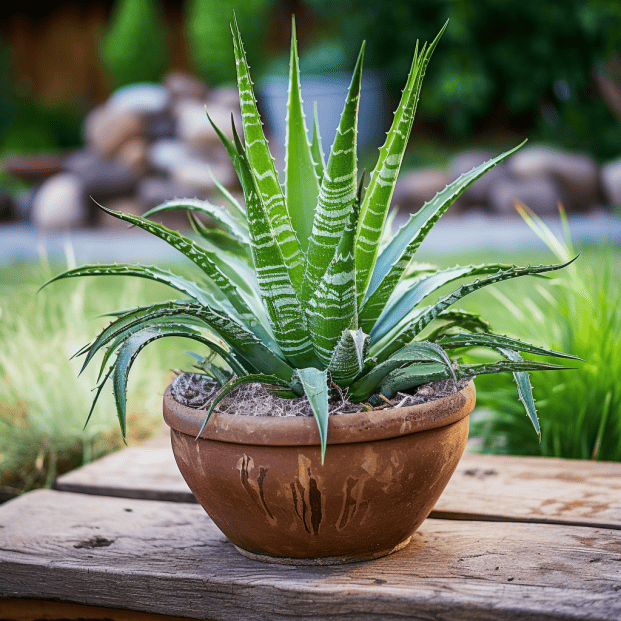
Echeveria, with its symmetrical rosette shape.

Haworthia, recognized for its translucent fleshy leaves.

Sempervivum, commonly called ‘hen-and-chicks’ for its clustering growth habit.
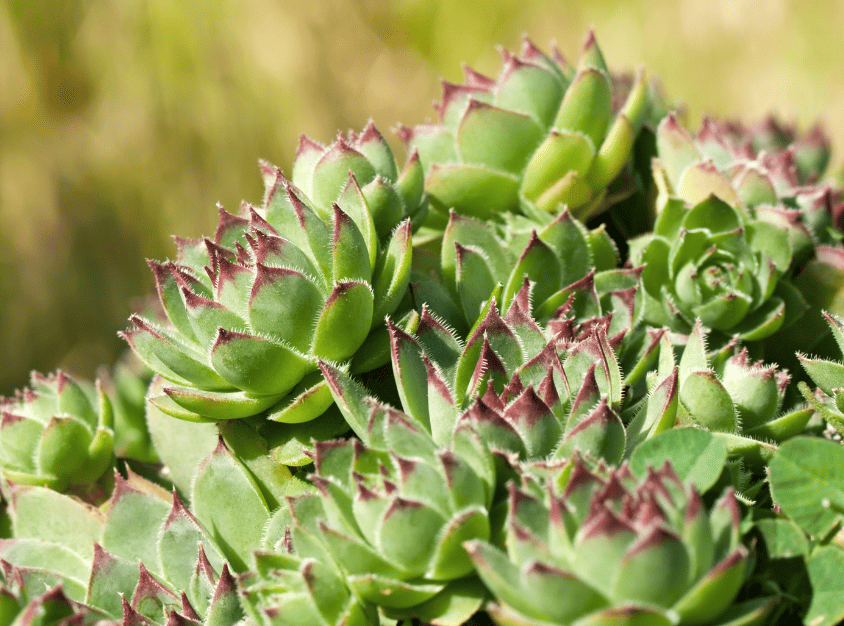
And gymnocalycium, a genus of globular cacti. These plants require minimal water and resemble the diverse flora found in desert landscapes.
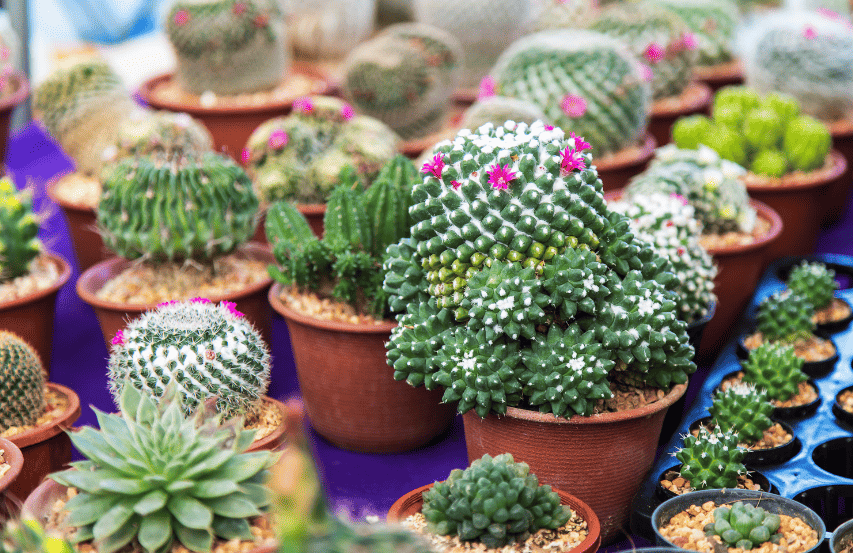
Understanding Desert Plant Needs
It’s important to recognize that desert plants have specialized adaptations to survive in environments with scarce water. For instance, succulents store moisture in their leaves, while cacti have spines that reduce water loss and protect them from sunburn. When creating a desert terrarium, replicating these conditions is key to maintaining plant health.
Combining Colors and Textures
The aesthetic appeal of a desert terrarium lies in the skillful combination of colors and textures. Incorporating a variety of hues from the muted greens of haworthia to the vibrant reds and purples of some echeveria species can make the terrarium more visually striking. Additionally, the contrasting textures between smooth-leaved succulents and spiky cacti add depth and interest to the display.
Creating Your Landscape
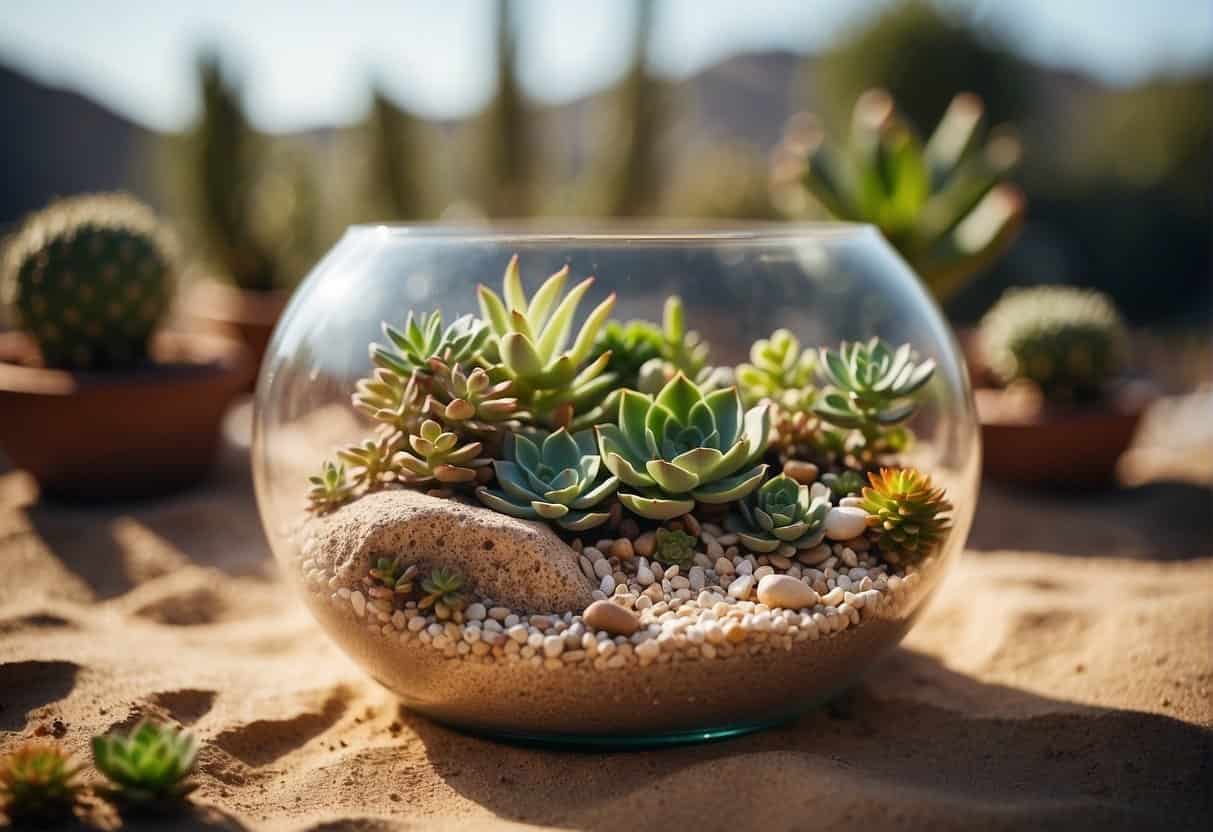
Creating a desert terrarium landscape requires careful consideration of design principles, substrate layering, and the strategic placement of decorations and plants. By focusing on these elements, one can create a stunning miniature desert ecosystem.
Design Principles for Desert Terrariums
The design of a desert terrarium should mimic the natural environment of arid landscapes. This involves choosing a wide, open container to prevent humidity build-up and selecting plants that thrive in dry conditions. Aesthetic appeal is achieved through minimalist arrangements and ensuring visibility of each plant.
Layering Substrate and Soil
Substrate layering is crucial for drainage and plant health. Start with a layer of gravel or pebbles for water management, followed by a thin layer of activated charcoal to filter impurities. Add a generous layer of specially formulated potting mix suitable for cacti and succulents to promote healthy root growth.
Placing Rocks, Pebbles, and Driftwood
Incorporating rocks, pebbles, and driftwood helps recreate the desert’s texture and provides microclimates within the terrarium. Strategically place these elements to create balance and contrast without overshadowing the plants.
Planting and Arranging Your Flora
Planting requires gentle handling to avoid damage. Use tongs or wrap the cacti in paper to safely place them in the terrarium. Arrange your plants with enough space to grow, and consider how each species will complement the others in terms of size, shape, and color.
Caring for Your Desert Terrarium
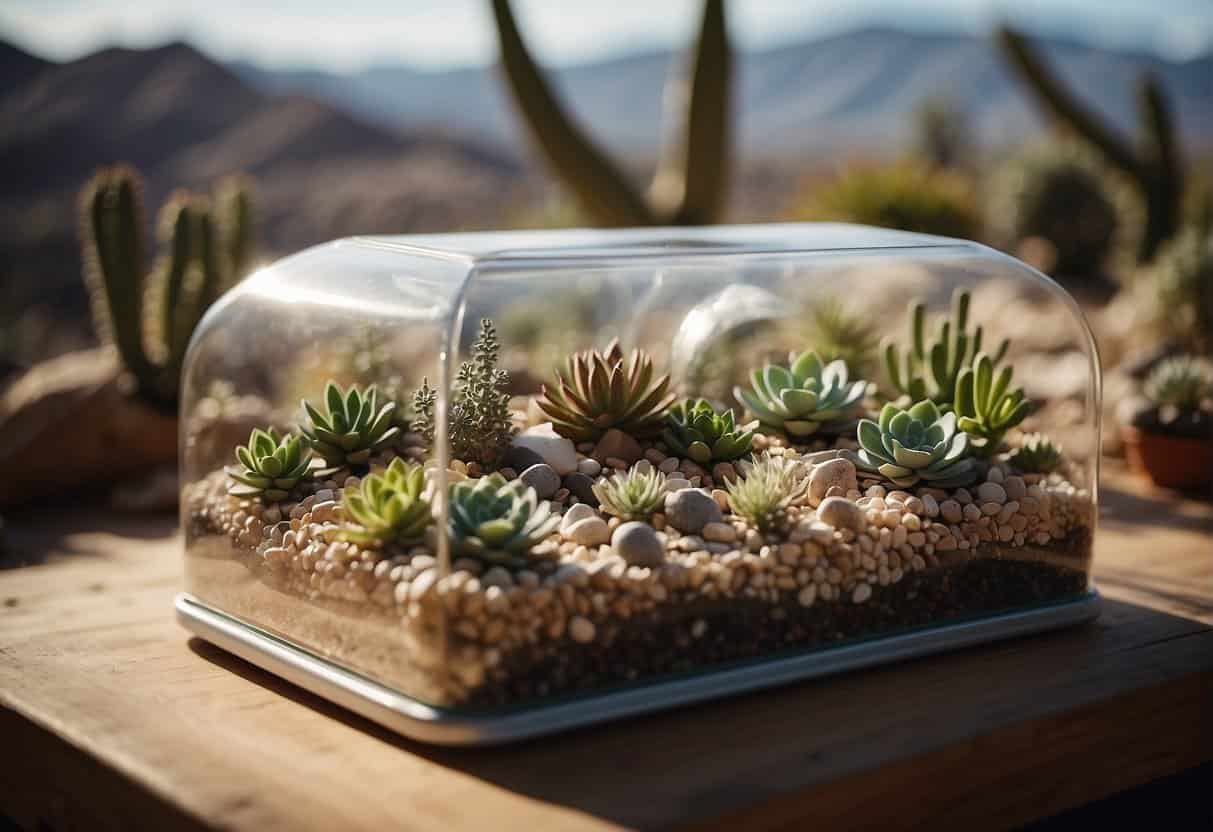
Maintaining a desert terrarium involves specific techniques to ensure the health and beauty of its arid environment. Consistent care and attention to watering, lighting, spacing, and maintenance are essential.
Watering Techniques and Managing Humidity
Water is crucial, yet excessive moisture leads to problems like mold and root rot. For desert terrariums, a sparse watering schedule is ideal—only water when the soil is completely dry. Humidity levels should be kept low, as desert plants thrive in dryer conditions. Good drainage is fundamental to avoid water retention, which can be achieved by layering gravel or pebbles at the terrarium’s base.
Proper Lighting Conditions
Desert plants demand ample lighting to mimic their natural habitat. Placing the terrarium in areas that receive several hours of indirect sunlight or using artificial grow lights for about 12 to 14 hours a day creates the proper conditions for growth. Adjust the light source if plants show signs of distress or etiolation.
Avoiding Overcrowding and Overwatering
Overcrowding can lead to reduced ventilation and increased humidity, both of which are detrimental in a desert terrarium. Space plants adequately to encourage airflow. Overwatering is a common misstep; it heightens the risk of root rot and should be diligently avoided. Water sparingly, allowing the soil’s top layer to dry out completely between sessions.
Routine Maintenance and Troubleshooting
Regular maintenance includes trimming dead or overgrown foliage, which helps prevent mold and diseases. Regular inspection for signs of distress or pests and appropriate troubleshooting keeps the terrarium healthy. Desert terrariums are relatively low-maintenance, but prompt reactions to issues such as poor ventilation or incorrect watering are crucial for preserving their intricate ecosystems.
Additional Elements and Considerations
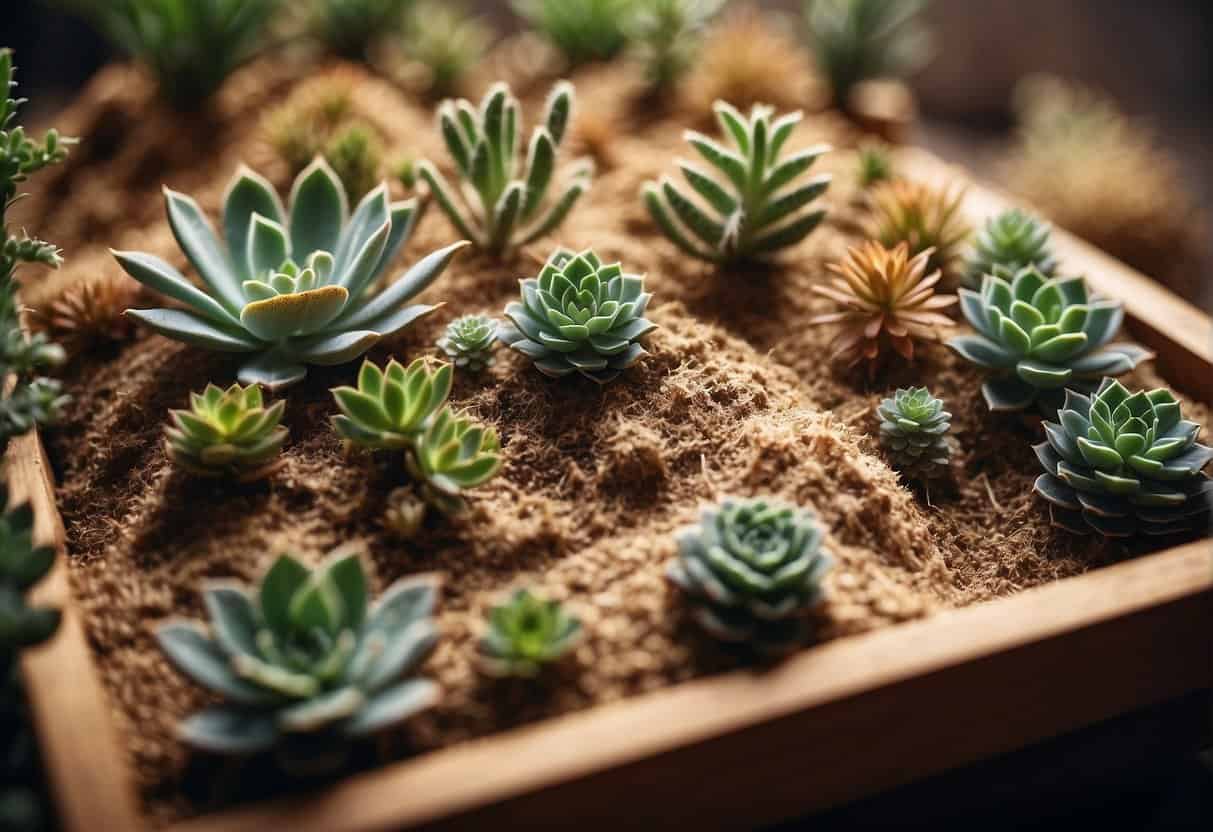
Creating a desert terrarium is more than assembling sand and succulents. It involves curating a balanced ecosystem and attending to the specific needs of both flora and fauna. Making informed decisions about the inclusion of animals, climate control, and construction are crucial for the thriving of your miniature desert habitat.
Incorporating Fauna
When introducing animals into a desert terrarium, one must select species that are suited to arid environments. Leopard geckos are popular reptiles for this type of ecosystem due to their adaptability and ease of care. They require a layered substrate to burrow and areas to climb. It is critical to research each animal’s needs. Some lizards might have specific humidity and space requirements to ensure their well-being.
Temperature and Climate Control
Maintaining the correct temperature and climate is pivotal for a healthy terrarium. Desert ecosystems necessitate a gradient of warmth, generally achieved using heating pads or lamps. It’s essential to monitor temperatures closely, providing a basking area at one end of the terrarium, while the other end remains cooler. Adequate UVB lighting is also crucial for the health of both plants and reptiles, aiding in their natural physiological processes.
Conclusion
In the whimsical world of botanical creativity, crafting a dessert terrarium is an art form. As you delicately arrange the miniature landscape, each succulent and grain of sand becomes a testament to nature’s intricate design. The allure of the desert ecosystem, with its resilience and understated beauty, is encapsulated within the glass confines of your terrarium.
Dessert terrariums transcend mere decor; they are living dioramas, inviting admiration for their meticulous arrangement and harmonious coexistence. Picture the subtle play of light on the arid landscape, casting shadows that dance with the mystique of a sun-soaked desert. The succulents, with their water-storing prowess, stand as resilient inhabitants, thriving in the simulated arid environment you’ve curated.
As you gaze upon your creation, there’s a sense of accomplishment in transforming a mere vessel into a miniture dessert. Cultivating and caring for your dessert terrarium isn’t just a pastime; it’s a journey into the heart of botanical artistry, where each layer tells a story of survival and aesthetic brilliance. May your dessert terrarium continue to captivate, inspire, and serve as a testament to the beauty that flourishes even in the most unexpected places.


